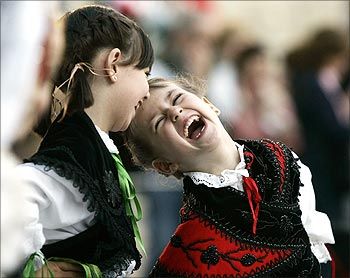‘Happiness is not something you postpone for the future; it is something you design for the present.’ -- Jim Rohn.
To lead a life with happiness, peace, and opportunities to use their skills to improve their wealth is a dream of every human being in the world. It is the responsibility of each country’s government to provide a happy life to its citizens. To see how the countries have performed in order to give that happy life to their citizen, Rediff Labs analysed the data on happiness, peace and human development for countries all over the world.
World Happiness Index
World Happiness Index is a measure of happiness published by United Nations Sustainable Development Solutions Network. To measure the happiness, they have considered six factors.
The six factors are: gross domestic product per capita, healthy life expectancy, social support, generosity, freedom to make life choices, and freedom from corruption.
The map below shows the change in happiness score from 2015 to 2016 for each country in the world. The size of the circle shows the happiness score for 2016. The happiness index scores are in a scale of 1 to 10.
In countries like Bulgaria, Afghanistan, Syria, Egypt etc, the happiness index has increased from 2015 to 2016 even though they are in the lowest ranks in 2016.
In countries like Venezuela, Algeria, Haiti, Zimbabwe and Brazil, the happiness index has highly decreased from 2015 to 2016. India has slipped from being 118th happiest country in the world to the 122nd spot with a decrease in happiness score.
Change in happiness index score from 2015 to 2016
Global Peace Index
Global Peace Index is the world’s leading measure of global peacefulness produced by the Institute for Economics and Peace.
GPI shows the negative peace of the country. Negative peace is the absence of violence or the fear of violence. The Index gauges global peace using three broad themes: the levels of safety and security in society, the extent of domestic or international conflict and the degree of militarisation.
The GPI is composed of 23 qualitative and quantitative indicators from highly respected sources and now ranks 164 independent states and territories covering 99.7 per cent of the world’s population.
Change in negative peace index score from 2015 to 2016
The map above shows the change in negative peace from 2015 to 2016. The size of the circle shows 2016 negative peace index of each country.
Countries like Yemen, Ukraine, Libya, turkey and Saudi Arabia shows the change in negative peace from 2015 to 2016 is increased which means peace is highly reduced.
In countries like Madagascar, Israel, Rwanda, Niger and Myanmar, the change is negative, which means these countries have become more peaceful.
In case of India, the change in negative peace from 2015 to 2016 has increased, which shows a reduction in peacefulness.
Human Development Index
Human development is about enlarging freedoms so that all human beings can pursue their choices. The Human development Index is one such tool for identifying deprivations in a selection of essential capabilities like a long and healthy life, knowledge and a decent standard of living.
The HDI data is taken from human development report published by United Nations Development Programme. The components of HDI are life expectancy at birth, expected years of schooling, mean years of schooling and gross national income per capita.
Change in Human Development Index score from 2015 to 2016
The map shows change in HDI score from 2015 to 2016. The size of the circle shows 2016 HDI of that country.
Countries like Albania, Malawi, Eritrea, Senegal and Uzbekistan show a high improvement from 2015 to 2016. At the same time, HDI for countries like Syria, South Sudan, Yemen and Kuwait is highly deteriorated.
HDI of India has highly improved compared to its neighbouring countries.

For more data stories go to Rediff Labs











 © 2025
© 2025